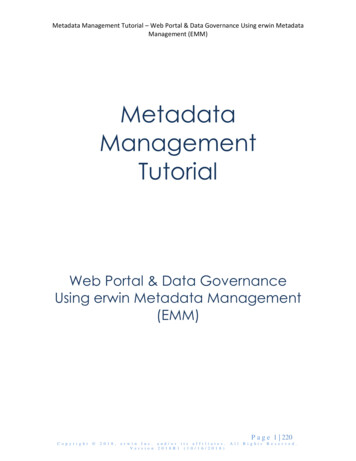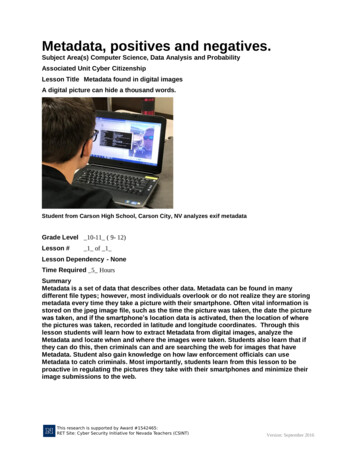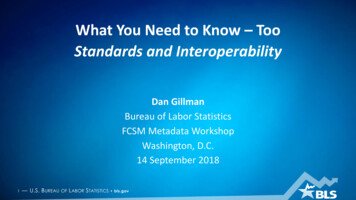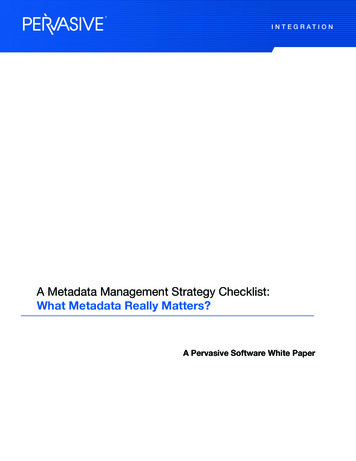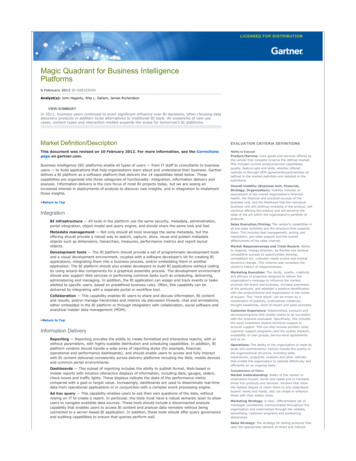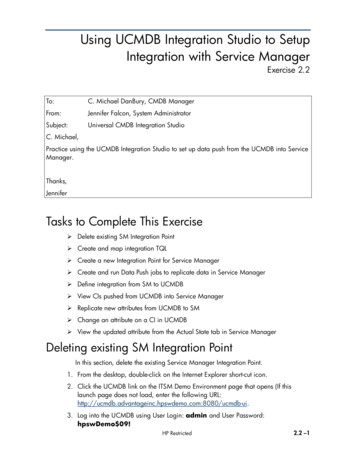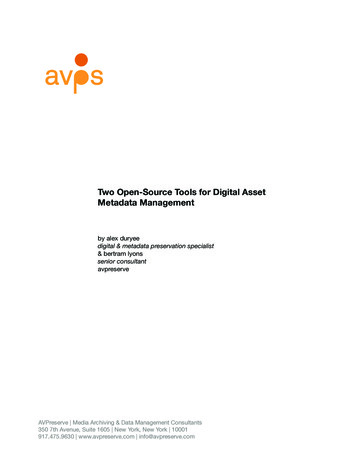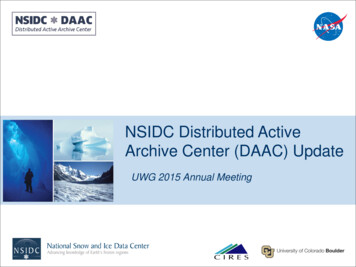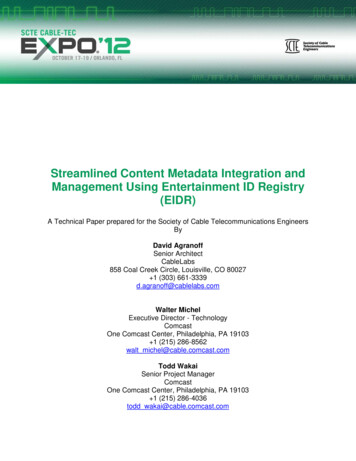
Transcription
Streamlined Content Metadata Integration andManagement Using Entertainment ID Registry(EIDR)A Technical Paper prepared for the Society of Cable Telecommunications EngineersByDavid AgranoffSenior ArchitectCableLabs858 Coal Creek Circle, Louisville, CO 80027 1 (303) 661-3339d.agranoff@cablelabs.comWalter MichelExecutive Director - TechnologyComcastOne Comcast Center, Philadelphia, PA 19103 1 (215) 286-8562walt michel@cable.comcast.comTodd WakaiSenior Project ManagerComcastOne Comcast Center, Philadelphia, PA 19103 1 (215) 286-4036todd wakai@cable.comcast.com
OverviewAs cable operators receive video content and associated metadata from an increasingnumber of sources, identification, management, tracking, measurement, and integrationbecomes increasingly more challenging. At the same time cable operators have moreoptions for delivering content to their subscribers beyond traditional linear and VOD.Customers are looking for a highly integrated experience for consuming content in atimely fashion across multiple devices requiring a myriad of different formats. Thispaper will present the Entertainment ID Registry (EIDR) as the most effective means toprovide comprehensive integration of content and metadata.EIDR is a recently evolved international standard for identifying both discrete videocontent and video services (i.e. cable networks, stations). The effort has the backing ofmajor production studios, programmers, metadata purveyors and cable operators.EIDR provides a global identifier for various content types and establishes relationshipsthat are important for effective video distribution such as episodic series and movieedits.This paper will present real world challenges of integrating content across multipleplatforms and how EIDR provides an efficient and logical solution. Issues discussed willinclude content sources, metadata from multiple sources, multi-platform distribution,measurement, and challenges around transition and implementation.Introduction to EIDRThe Entertainment ID Registry (EIDR) is an industry non-profit organization with thepurpose of creating permanent, global identifiers for video entertainment assets. Theregistry is meant to assist B2B interactions throughout the digital and physical supplychain. It is supported by organizations across the supply chain through annual membercontributions. The solution is designed to be the international standard for video assetand service identification.
The EIDR registry is part of a larger ISO-approved initiative called Digital ObjectIdentifier (DOI), which is supported by the International DOI Foundation. DOI is in turnan implementation of the Handle System created by the Corporation for NationalResearch Initiatives. The important aspect of all of this is that just as digital videocontent is a part of all conceivable digital objects in the world, EIDR is a part of a largecommunity of digital object registries. The community of registries that make up DOIwork together to assure any DOI can be resolved to the appropriate digital object. TheDOI or handle remains permanent regardless of the location of the object, associatedmetadata, or ownership changes.EIDR maintains its handles within a central registry available to all participants. Thehandles assigned by EIDR are completely opaque and imply no ownership status orother metadata. This is in contrast to other identifier systems (ISBN, UPC), which issueblocks of identifiers to organizations where the origination can be derived by looking at apart of the identifier. EIDR recognized that digital content frequently changes ownershipand decided not to encode this information into the handle itself. Furthermore, EIDRdoes not charge its members a per transaction fee, so there is no cost benefit toacquiring handles in bulk.The EIDR registry associates the content handle with a minimal set of metadatarequired to maintain uniqueness and avoid duplication. The most fundamental type ofEIDR record is known as an abstraction as the concept of an original work with noparticular manifestation. An asset in the abstract includes enough metadata to establishits identity, such as its canonical title (ideally as defined by the creator), the date or yearof release, country of origin, original language and several (but not all) contributingagents. Usually the creator and major distributors are identified along with the directorand several key actors. This is typically enough information to uniquely resolve themajority of stand alone content to a single EIDR handle.Episodic content abstractions are further wrapped in abstractions for television seasonsand series. This relationship is necessary to uniquely distinguish the massive library ofexisting and future episodic content made for television. Episodic records inherit theadditional metadata from their related series and seasons making it much easier todefinitively match such content.Once the root creative content records are established, EIDR registrants are able tocreate additional unique embodiments that derive from the root. This forms ahierarchical tree in EIDR that provides valuable content relationships for its users. Each
variant of a video asset is assigned its own EIDR handle and connected to the parentabstraction. In this way, editions like unrated versions, director’s cuts, “edited for TV”and others are preserved as having derived from the same creative work. This is alsothe way that a language variant, where alternate language audio is dubbed over thevideo, is traced to its original version.Beyond variants in content, EIDR provides additional ways to classify assets. EIDRprovides unique handles for various digital encodings where needed, which is essentialto distinguish formats (SD, HD, 3D) from one another while preserving the relationshipbetween them as a common title. Unique records can be used to specify variouscodecs, bit rates or included subtitles. Because original content is routinely cut andrecombined, EIDR provides record types for clips and composites to maintain thoserelationships.While EIDR provides much valuable information for identifying content and itsrelationships, there is a lot of metadata that is outside its scope. Metadata about avideo that is transient, subject to business agreements or provides value beyondidentification is not stored or provided by EIDR. This limitation of scope allows businessopportunities and innovation to continue to thrive within the video entertainment industrywhile EIDR only tackles the common industry task of content identification.Figure 1 Scope of EIDR
An actual EIDR handle is an IDF-assigned prefix, followed by an EIDR-assigned unique20 hexadecimal digit suffix and a check character. The canonical format typicallyincludes dashes for readability.Figure 2 – An EIDR identifierWhen the punctuation and extra information is removed, an EIDR handle can berepresented as a 96-bit number. The prefix 10.5240 is used for all content handles.EIDR also supports three additional handles for parties (organizations), users and videoservices.Video Services and InstancesEIDR provides handles for video services in addition to discrete video content. A videoservice is an abstract collection of unrelated (or loosely related) video, usually providedas a linear stream. This is critical for the cable television industry as this type of EIDRhandle is used to represent a cable network or broadcast station. Where a video assetis delivered as part of a video service there needs to be a way to uniquely and positivelyidentify the service. An EIDR video service handle will always have the DOI prefix of10.5239 to distinguish it from discrete video content.The combination of video service handle, video content handle, and additional contextidentifies a particular instance of video delivered by an operator. This ability to identifyvideo instances is important in authorization and measurement use cases where it is notenough just to know what content was watched, but the service used and conditionsunder which it was served. The most important context typically cited for an instance ofvideo is the date and time in which it is aired or consumed. Other contextual propertiesmight include neighboring content and device or platform. The relationship between thecomponents of a video instance is shown in Figure 3.
Figure 3 – Identifying an instance of videoUse CasesThe existence and proliferation of global content and service identifiers provide quite afew tangible benefits for cable operators and other distributors of video content. Most ofthese benefits appear in the form of improved user experiences, but cost-savingoperational efficiencies are available as well.Multi-platform ViewingOperators already provide multiple ways for their subscribers to consume video andmore operator-provided solutions are likely on the way. One of the most importantaspects of having multiple viewing platforms is to provide a coordinated user experiencethat leverages each platform in support of the others. This means allowing viewers tobe able to enjoy and discover content on any available platform and seamlessly switchbetween them. The common EIDR identifier allows platforms to link identical andassociated content across platforms without manual intervention. The linkage allowsthe viewer to switch between the same content on linear television, VOD, and IPdelivery networks subject to availability.
Figure 4 – Multi-platform viewingMetadata EnrichmentToday’s generation of Internet-savvy users have grown accustomed to easy access ofinformation including metadata about content that they enjoy. The challenge for cableoperators is to provide an integrated experience that includes rich metadata along withthe content. An EIDR-enabled metadata ecosystem enables the operator to license awide variety of information from 3rd parties and combine it without creating expensivemappings of proprietary identifiers. At a minimum the operator can more seamlesslymerge the presentation of linear television guide with VOD. A more engagingexperience might include detailed reviews from other sources, castbiographies/filmographies, time-indexed metadata and even comments from theviewer’s social network.MeasurementEffective measurement of content viewership is both timely and accurate. For both ofthese reasons, EIDR provides instant benefit to the operator and their programmingpartners. The most efficient measurement cycle requires that all participants have a
common understanding of the identity of the measureable asset including how it relatesto other assets that need to be aggregated.Figure 5 – Measurement cycle for VOD and Linear contentAssets in the VOD space are accompanied by a ProviderID and AssetID (PAID), whichshould theoretically make reporting straight forward. However, measurement on thisbasis does not accommodate related assets such as format variations. Furthermore,the same asset may be assigned multiple PAID values if they are re-pitched or evenredistributed within an operator’s network. Since the EIDR handle is consistent andtraceable back to the abstract work, these problems are alleviated.Linear television measurement is either enabled by coordinating viewership time andservice with the available schedule or by inserting proprietary identification markerswithin the content. While these schemes are somewhat effective, a more universalapproach would be to mark the content with EIDR handles, which provide the same
benefits as for VOD. The crafters of the SCTE-35 specification envisioned the use ofsegmentation descriptors, which carry the EIDR handle as part of the stream.Encryption or obfuscation of the descriptor would probably be warranted in cases wherethe identification was provided to a client device.Figure 6 – Using SCTE 35 segmentation descriptors for content identificationLinear television measurement may also take advantage of EIDR video service handlesto provide metrics based on service instead of program. Single services may beaggregated with related services to provide more insightful reporting.AdvertisingAn important aspect of effective dynamic targeted advertising is that part of the adplacement decision is based on the content being viewed. Having universal contentand service identifiers provides an unambiguous basis for an ad decision. The adsthemselves may be represented by a complementary identifier space called Ad-ID orEIDR handles can be generated for promotional content.AuthorizationTV Everywhere is an industry concept of having a paid subscriber for television servicealso be able to acquire entitled content through other platforms – even if not deliveredby the operator. This type of transaction requires coordinated authorization betweenthe operator and content provider for the service or content being sought. Once again,the use of universal identifiers for both content and service allows scalable, rather thanpoint-to-point, integration between content providers and operators.Social NetworkingSocial networking has become a popular way to share status and recommendationsbetween friends and family. Sharing actionable video content recommendations shouldbe no exception. EIDR provides a means to reference a video asset without regard tolocation of the asset or associating viewing rights. The EIDR handle serves as the
content or service identifier enabling each recipient to acquire the content from thedistributor/operator of their choice based on their subscription.Comcast ApproachAs a founding member of EIDR, Comcast has been quick to initiate proof-of-concepttrials using EIDR handles as the centerpiece for content identification. The approach isto receive EIDR handles along with content from upstream sources of video. Comcastreceives metadata for both its linear guide and along with VOD assets and is nowrequesting that EIDR handles accompany that metadata. 3rd party metadata providerswill also be asked to provide EIDR-powered metadata.Figure 7 – Comcast using EIDR to connect video contentProviding EIDR handles with VOD assets is conceptually simple for VOD providers.Both the legacy CableLabs ADI 1.1 and the latest Metadata 3.0 specifications providefor the passage of EIDR handles as part of the accompanying metadata. Ideally theVOD provider will receive the EIDR handle from their upstream source and simply passit on. However, given the volume of content already in circulation, a more realisticapproach is that the VOD provider will match their content catalog with EIDRthemselves. EIDR allows supply chain participants like VOD providers to match up theircatalogs and even register titles that do not already exist. Major VOD providers, suchas InDemand and Avail-TVN are already working with Comcast to provide EIDRhandles as part of their metadata.
EIDR-connected VOD assets provide several pertinent advantages for the cableoperator. The use of EIDR relieves the VOD provider from having to resend metadatawhen re-pitching assets. Indeed, the VOD provider can eventually omit sending somemetadata entirely as the operator can use EIDR to link in 3rd party metadata sources.The use of EIDR will allow the VOD platform to be more seamlessly integrated with theother content delivery platforms (e.g. linear, on-line). EIDR provides linkages ofepisodic content to a common series thus allowing useful series rollups that werepreviously assembled manually. Usage reporting from operator back to the VODcontent provider is also greatly improved by allowing unambiguous identification androllups of both series and formats (e.g. SD, HD, 3D).Linear television content, such as that provided by broadcast stations and cablenetworks, is identified currently through 3rd party companies that assemble schedulesand compile associated metadata. These metadata feeds are historically providedusing proprietary IDs that are not easily associated with other content or metadatasources. The benefit of having linear content associated to EIDR allows operators tomore easily create the connection with other sources that provide EIDR. By connectingto other metadata sources, an operator can incorporate supplemental material covetedby their users. This material includes helpful reviews and expanded cast and crew listswith extensive ways to cross reference content. Common genres are now enabled tosearch across multiple platforms and the display of titles and descriptions are alsoconsistent. Increasing use of graphic content navigation necessitates a comprehensivemethod for acquiring, associating and managing promotional artwork in a consistent andreliable way. Just as with VOD, the operator will roll-up content into common groupingsof episodic series, formats and alternate editions of the same base content. Comcasthas been working with Rovi, another founding EIDR member and provider of linearguide data, to associate its lineup of television content with EIDR handles.There are quite a few additional features enabled by EIDR for Comcast: Remote tuning and remote DVR capabilities The ability to present alternate viewing options:o Linear to “Watch On Demand”o Standard definition to “Watch in HD”o 2 Dimensional content to “Watch in 3D” Families of Channels can be rolled up to create network branded and premiumtiers of content (Mini-guides) 3rd parties can provide more accurate and definitive tune-in recommendations Playlists and favorites lists may be shared across various platforms and evenamong users
Synchronization with 2nd screen applications are more reliable with definitivecontent and service identificationConclusionThe use of EIDR provides a universal, cross-industry approach for identifying bothdiscrete content and video services. The combination of reliable content and serviceidentification allows cable operators and other video distributors to execute new andexciting use cases that were impractical or prohibitively difficult in the past. Comcast isalready successfully demonstrating multi-platform, metadata enrichment andmeasurement use cases through POC trials underway. Increased participation by allvideo supply chain partners in this cooperative, non-profit effort is essential for industrysuccess.BibliographyEntertainment ID Registry, http://eidr.orgCableLabs VOD ecifications/index.htmlSCTE 35 2012, Digital Program Insertion Cueing Message for Cable.Abbreviations and s to BusinessCorporation for National Research InitiativesDigital Object IdentifierDigital Video RecorderEntertainment ID RegistryHigh DefinitionInternational DOI FoundationInternational Standard Book NumberInternational Organization for StandardizationUniversal Product CodeVideo On Demand
Comcast . One Comcast Center, Philadelphia, PA 19103 1 (215) 286-8562 . walt_michel@cable.comcast.com. . EIDR is a recently evolved international standard for identifying both discrete video content and video services (i.e. cable networks, stations). . subject to business agreements or provides value beyond
